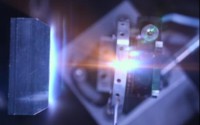Fifty Years Of Lasers: Turning light into matter, from the basics of nuclear fusion and beyond
- Date
- 24 Jan 2012
- Start time
- 7:30 PM
- Venue
- Tempest Anderson Hall
- Speaker
- Dr Nigel Woolsey

Fifty Years of Lasers: Turning light into matter, from the basics to particle creation
Nigel Woolsey, York Plasma Institute, Department of Physics, University of York
First lecture in a series of three celebrating the 50th anniversary of the LASER
More than five decades have passed since the invention of the laser, and since then great strides have been made in the quest for ever more powerful lasers. This 50-year history spans the use of powerful lasers for machining and welding materials, the acceleration of particles to relativistic speeds and the production of fusion energy. Future lasers will be so powerful that the creation of matter from light becomes possible. We will start from the basic principles of lasers and proceed through the enabling technology that gives lasers powers exceeding the worlds electrical power generation capacity. The UK is home to Vulcan; at a petawatt (1,000,000,000,000,000,000 W or 1015 W) this is one of the most powerful lasers in the world. This talk will cover the extraordinary science possible with lasers like Vulcan, a story of extremes which enables us to test our most sophisticated theories and offers the potential for a clean source of energy.
Featured photograph shows the Vulcan petawatt laser approaching from the right and interacting with target towards the centre. A relativistic beam of electrons leaves the target and strikes a detector on the left. (Photo credit: Rob Clarke, STFC)
Report
by Ken Hutson
Albert Einstein first raised the possibility of the laser in 1917, but it was 1960 before Theodore Maiman operated the first functioning laser. It is a device that emits a focussed beam of light through a process of optical amplification based on the stimulated emission of photons. Many processes now use lasers, but they continue to have huge potential.
In 2009 the recently-completed National Ignition Facility in California conducted the first experiments using powerful lasers to heat and compress hydrogen fuel to the point where nuclear fusion takes place. Research continues elsewhere towards developing nuclear fusion, as a clean way of producing electricity, and more powerful and larger lasers requiring massive buildings are being developed. Competitive facilities in France, Germany, Japan, the USA and UK spend billions on such research.
At the end of this challenging lecture came the startling throwaway revelation that light beams colliding in a vacuum can produce matter or something out of nothing.